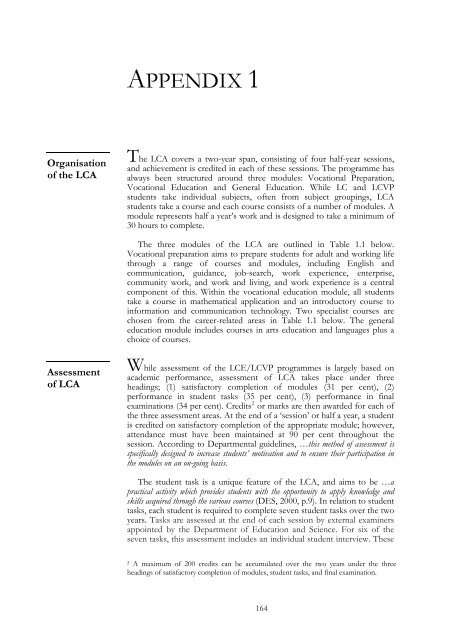Student Experiences of the Leaving Certificate Applied Programme
Student Experiences of the Leaving Certificate Applied Programme
Student Experiences of the Leaving Certificate Applied Programme
Create successful ePaper yourself
Turn your PDF publications into a flip-book with our unique Google optimized e-Paper software.
APPENDIX 1Organisation<strong>of</strong> <strong>the</strong> LCAThe LCA covers a two-year span, consisting <strong>of</strong> four half-year sessions,and achievement is credited in each <strong>of</strong> <strong>the</strong>se sessions. The programme hasalways been structured around three modules: Vocational Preparation,Vocational Education and General Education. While LC and LCVPstudents take individual subjects, <strong>of</strong>ten from subject groupings, LCAstudents take a course and each course consists <strong>of</strong> a number <strong>of</strong> modules. Amodule represents half a year’s work and is designed to take a minimum <strong>of</strong>30 hours to complete.The three modules <strong>of</strong> <strong>the</strong> LCA are outlined in Table 1.1 below.Vocational preparation aims to prepare students for adult and working lifethrough a range <strong>of</strong> courses and modules, including English andcommunication, guidance, job-search, work experience, enterprise,community work, and work and living, and work experience is a centralcomponent <strong>of</strong> this. Within <strong>the</strong> vocational education module, all studentstake a course in ma<strong>the</strong>matical application and an introductory course toinformation and communication technology. Two specialist courses arechosen from <strong>the</strong> career-related areas in Table 1.1 below. The generaleducation module includes courses in arts education and languages plus achoice <strong>of</strong> courses.Assessment<strong>of</strong> LCAWhile assessment <strong>of</strong> <strong>the</strong> LCE/LCVP programmes is largely based onacademic performance, assessment <strong>of</strong> LCA takes place under threeheadings; (1) satisfactory completion <strong>of</strong> modules (31 per cent), (2)performance in student tasks (35 per cent), (3) performance in finalexaminations (34 per cent). Credits 2 or marks are <strong>the</strong>n awarded for each <strong>of</strong><strong>the</strong> three assessment areas. At <strong>the</strong> end <strong>of</strong> a ‘session’ or half a year, a studentis credited on satisfactory completion <strong>of</strong> <strong>the</strong> appropriate module; however,attendance must have been maintained at 90 per cent throughout <strong>the</strong>session. According to Departmental guidelines, …this method <strong>of</strong> assessment isspecifically designed to increase students’ motivation and to ensure <strong>the</strong>ir participation in<strong>the</strong> modules on an on-going basis.The student task is a unique feature <strong>of</strong> <strong>the</strong> LCA, and aims to be …apractical activity which provides students with <strong>the</strong> opportunity to apply knowledge andskills acquired through <strong>the</strong> various courses (DES, 2000, p.9). In relation to studenttasks, each student is required to complete seven student tasks over <strong>the</strong> twoyears. Tasks are assessed at <strong>the</strong> end <strong>of</strong> each session by external examinersappointed by <strong>the</strong> Department <strong>of</strong> Education and Science. For six <strong>of</strong> <strong>the</strong>seven tasks, this assessment includes an individual student interview. These2 A maximum <strong>of</strong> 200 credits can be accumulated over <strong>the</strong> two years under <strong>the</strong> threeheadings <strong>of</strong> satisfactory completion <strong>of</strong> modules, student tasks, and final examination.164

















